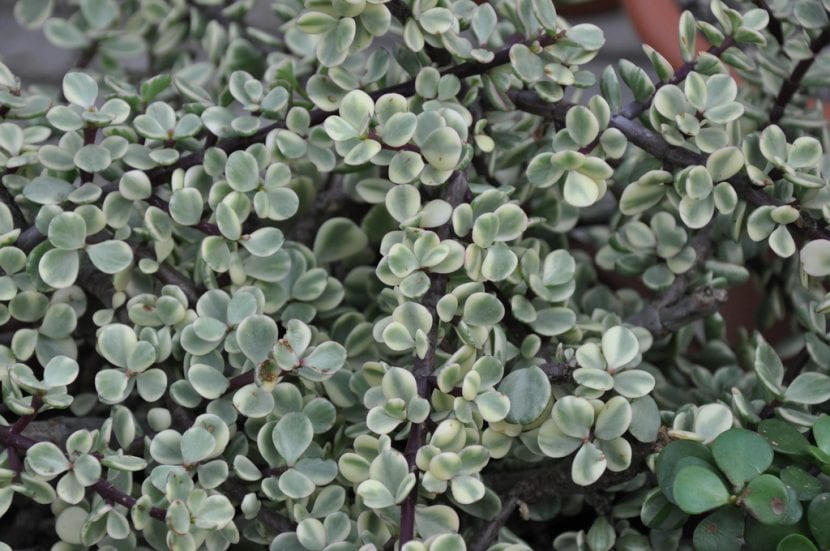
May the name Afra portula don't tell you anything, but I'm sure you've seen this plant more than once when visiting a nursery or garden store. And it is that those rounded succulent leaves of green or variegated color are very easy to distinguish 😉.
It is very easy to care for, so much so that it is suitable for beginners. In addition, you can have it both in the garden and in a pot. You just have to take into account our advice so that it is perfect.
Origin and characteristics

Our protagonist is a non-cactus succulent plant native to South Africa whose scientific name is Afra portula. It is popularly known as an elephant bush, although it can confuse us since it is not a tree, but a bush or, at most, a small tree. It reaches a height of between 2,5 and 4,5 meters.
It develops cylindrical stems, from which leaves less 1cm or less, fleshy, and green, or variegated (Portulacaria afra f. variegate). The flowers are grouped in inflorescences and appear in summer.
What are their cares?
If you want to have a specimen, provide it with these care to be able to enjoy it more:
Location
It can be both outside and inside, but it is important that it is placed in a bright area since it does not live well in semi-shade.
Earth
- Flower pot: universal culture substrate mixed with perlite in equal parts.
- Garden: it is indifferent as long as it has good drainage.
Irrigation
Moderate to low. It must be watered by letting the substrate or soil dry between waterings. To have more or less an idea, in summer it will be watered no more than twice a week, and the rest of the year every 10-15 days.
Subscriber
From early spring to late summer (It can even be done in autumn if you live in an area with a mild climate or without frost) it should be paid with specific fertilizers for cacti and other succulents. This has to be liquid if it is grown in a pot, but it can be in granules if it is in the ground.
Planting or transplanting time

The ideal time to plant it in the garden is in spring, when the risk of frost has passed. If you have it in a pot, you must transplant it every two years.
Multiplication
La Afra portula it multiplies by seeds or, more frequently, by stem cuttings. Let us know how to proceed in each case:
Seeds
The step by step to follow is the following:
- First, in spring or summer fill a seedling tray (like this one you can get here) with universal culture substrate mixed with perlite in equal parts.
- Second, water in such a way that the substrate is very wet.
- Third, place 2-3 seeds in each socket and cover them with a very thin layer of substrate.
- Fourth, water, this time with a sprayer.
- Fifth, introduce the seedling into a tray without holes.
Now all you have to do is put everything in a bright area and water, preventing the substrate from losing moisture. Thus, they will germinate in 2-3 weeks.
Stem cuttings
The step by step to follow is the following:
- First, in spring, you have to cut a stem with leaves that looks healthy.
- Second, you must let the wound dry for a week in semi-shade.
- Third, after that time, you plant it in a pot with a universal growing medium mixed with equal parts perlite.
- Fourth and last, you will only have to water and place the pot in a bright area.
In about 3 weeks it will begin to emit its own roots.
Pests

It is a fairly resistant plant. However, it would not be unusual for, especially in summer, to have some aphid o cottony mealybug. But these attacks are not serious, and in fact, with a small brush and a little water they can be easily removed.
Management
When overwatered, the base of the stem rots. In doing so, fungi such as Phytopthora can harm you. Treatment consists of applying fungicides and watering only when necessary.
Rusticity
Resists cold and frost up to -2ºC.
What uses is it given?
Garden or pot plant
La Afra portula It is a plant that is used as an ornamental. As we have mentioned, it can be had both in a pot and in the garden, and it is very easy to care for.
Bonsai Afra portula

Image - Worldofsucculents.com
Another use that is given is that of bonsai. Their care is as follows:
- Location:
- outside: in full sun.
- indoor: in a room with plenty of natural light.
- Substratum: 70% akadama with 30% kiryuzuna.
- Irrigation: 2 times a week in summer, and every 6-7 days the rest of the year.
- Subscriber: from spring to autumn with a liquid bonsai fertilizer.
- Pruning: at the end of winter, dry, diseased or weak branches should be removed. In addition, you also have to trim those that have grown too much, allowing 3-4 knots to grow and removing 1-2.
- Transplant: every 2-3 years, in spring.
- Rusticity: supports up to -2ºC, but it is better not to drop below 0º.
Enjoy your Afra portula 🙂.
Hello, this plant can be eaten, what happens if I eat or what happens if the boys eat ... thank you very much
Hello Laura.
We do not recommend its use. We have not found any scientific study that talks about whether or not it can be eaten, so when in doubt it is better not to risk it.
Greetings.